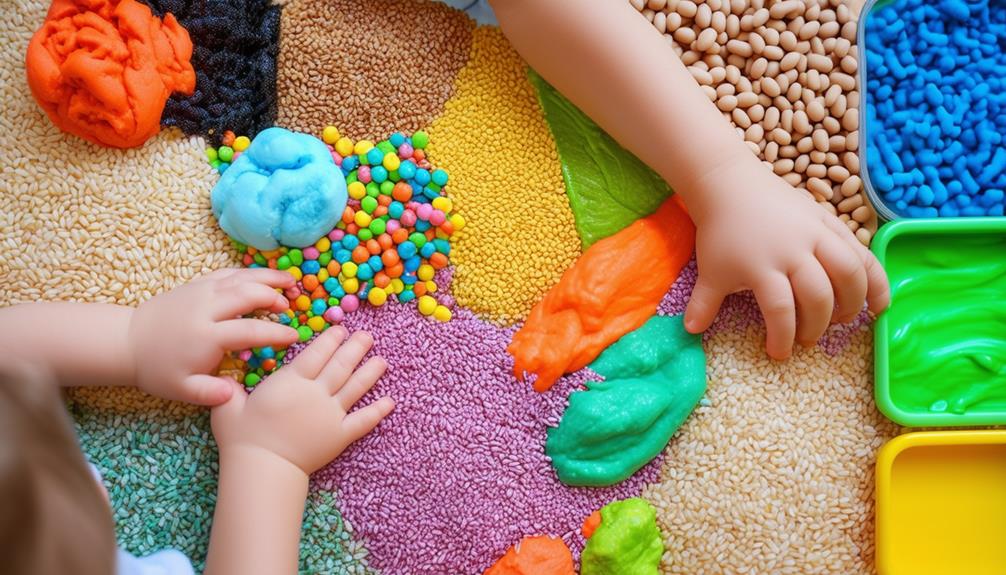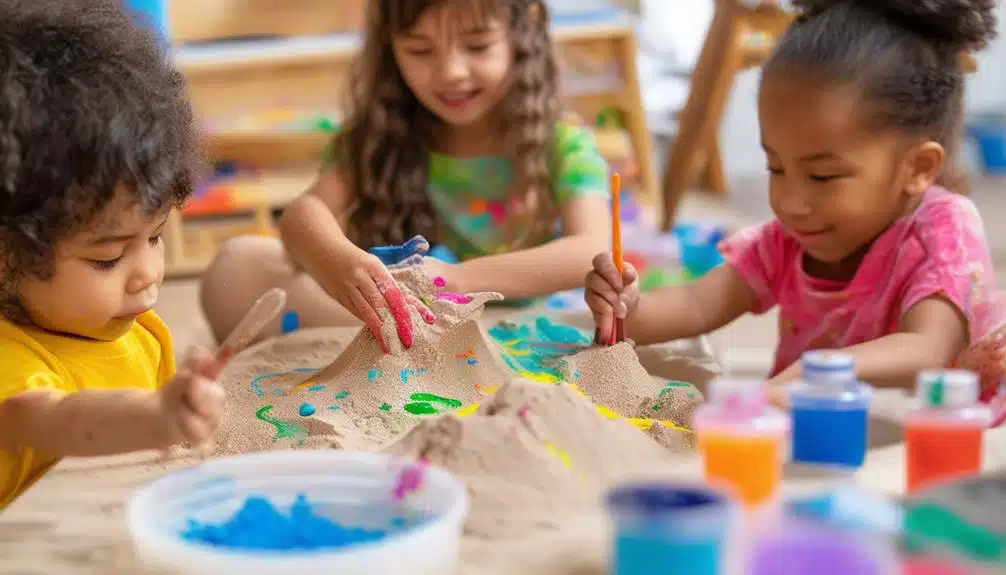Children’s sensory processing abilities are a cornerstone of their cognitive and physical development. There are many ways to foster this essential growth aspect, including tactile stimuli, proprioceptive challenges, visual stimulation techniques, and deep-pressure calming strategies. With the right approach and understanding, parents and caregivers can significantly enhance their child’s sensory integration, leading to more effective learning and interaction with their environment. How, you might ask? Let’s explore twelve compelling strategies that can be instrumental in improving your child’s sensory processing.
Key Takeaways
- Implement tactile sensory activities like finger painting and sensory bins to stimulate touch senses and improve confidence.
- Enhance body awareness through movement-based activities such as obstacle courses and resistance band exercises.
- Use visual sensory stimulation techniques like light-up toys and calming sensory bottles to promote active learning and engagement.
- Develop oral motor skills and improve focus through sensory exploration through chewy snacks and blowing activities.
- Improve balance and coordination with vestibular activities like sensory swings and mini trampolines.
Understanding Sensory Processing Challenges
Understanding sensory processing challenges in children requires keen awareness that these can manifest as over-responsiveness or under-responsiveness to sensory stimuli, with signs ranging from sensitivity to noise, touch, and textures to behavioral changes, meltdowns, or withdrawal. This sensitivity can profoundly impact a child’s daily activities and interactions, necessitating appropriate support and understanding from caregivers and educators.
Children with sensory processing challenges may be easily overwhelmed in environments that most would find tolerable. A sudden loud noise or an unexpected touch could trigger a meltdown or cause withdrawal. Conversely, they may be under-reactive, showing little to no response to stimuli that typically elicit a reaction. These children might appear unaware of discomfort, pain, or extreme temperatures.
Understanding a child’s distinct sensory needs and triggers is fundamental to offering practical support. Sensory breaks, calming environments, and personalized sensory tools can significantly help manage these challenges. Recognizing and respecting the child’s sensory needs can create an environment supporting their growth and development. This understanding can foster empathy, promote inclusivity, and ultimately enable us to serve these children more meaningfully and positively.
Exploring Proprioception and Vestibular Senses
Examining the roles of proprioception and vestibular senses is essential to enhancing a child’s sensory processing. These two systems, integral to body awareness, movement, balance, and spatial orientation, can pose significant challenges when they do not function at their best. By understanding these challenges and exploring methods to boost proprioceptive and vestibular coordination, we can help children navigate their world with greater confidence and ease.
Understanding Proprioceptive Challenges
Children with sensory processing challenges may often struggle with proprioception, the body’s innate ability to perceive its position in space and gauge the force used during movement. This lack of body awareness can lead to difficulties in judging force, impacting activities like writing or playing sports. It’s essential to understand that proprioceptive challenges can have far-reaching consequences on a child’s development and daily life.
To better comprehend these difficulties, consider the following:
- Children with proprioceptive challenges may have difficulty controlling their movements, often appearing clumsy or uncoordinated. They may accidentally break objects due to an inability to gauge the force required for specific tasks.
- These challenges can also lead to difficulty maintaining balance, which is closely tied to the vestibular sense and further complicates matters.
- Certain activities, such as bouncing on a trampoline or swinging, can provide sensory input that helps improve proprioceptive functioning.
Boosting Vestibular Coordination
As we investigate sensory processing further, it is essential to recognize the significant role that proprioception and vestibular senses play in maintaining body awareness and balance. Any vestibular challenges can lead to clumsiness and difficulty coordinating movements. However, many strategies and tools can help a child improve these crucial senses.
Among the many options, sensory swings, mini trampolines, yoga balls, wobble seats, and swivel cushions can provide sensory input and improve coordination. These tools offer dynamic movement opportunities that challenge the vestibular and proprioceptive senses, enhancing one’s ability to maintain balance and control their movements.
Take a look at this table to better understand these activities and their benefits:
| Activity | Tool Used | Benefit |
|---|---|---|
| Sensory Swings | Sensory Swings | Enhances balance, coordination, and sensory integration |
| Jumping | Mini Trampolines | Supports body awareness, rhythm, and coordination |
| Sitting | Yoga Balls, Wobble Seats, Swivel Cushions | Improves focus and provides sensory input |
| Moving Freely | Dance Parties, Gymnastics | Boosts coordination, rhythm, and vestibular input |
Implementing Tactile Sensory Activities

Embracing tactile sensory activities, such as finger painting and shaving cream play, offers children an enriching opportunity to explore varying textures and stimulate their sense of touch. These activities are essential to assist children, especially those facing sensory processing challenges, navigate their sensory world confidently.
Furthermore, implementing tactile sensory activities can seamlessly integrate into a child’s routine. Here are three practical suggestions for tactile sensory play:
- Sensory Bins: Filled with items of different textures, sensory bins allow children to engage in hands-on sensory exploration.
- Texture-filled Scavenger Hunts: This activity encourages children to find items with various textures, promoting tactile exploration and awareness.
- Bumpy Play Dough and Paper Tearing: These activities provide distinct tactile stimulation, enhancing children’s sensory processing skills.
Building Body Awareness Through Movement
Fostering body awareness through movement-based activities presents a dynamic approach to enhancing a child’s sensory processing capabilities. Engaging children in obstacle courses and animal movements improves their motor skills and body awareness. These activities require them to be attentive to their body’s positioning, strengthening their sensory input.
Practicing bodyweight exercises and playing on soft surfaces also offer valuable sensory input. These actions stimulate the child’s tactile senses, enabling them to better perceive and react to their surroundings. Resistance bands and therapy balls can further strengthen muscles and joints, intensifying the child’s sensory experiences.
Incorporating sensory swings, mini trampolines, and scooters can enhance balance and coordination. These tools provide varying degrees of movement, allowing the child to experiment with different body positions and movements. Similarly, tools like yoga balls, wobble seats, and swivel cushions can also offer sensory input and help improve focus.
Visual Sensory Stimulation Techniques

Moving from body awareness to the realm of sight, visual sensory stimulation techniques offer an array of activities designed to engage and enhance a child’s visual senses. These interactive techniques promote active learning, which is essential to a child’s sensory development.
- Calming Sensory Bottles: These are remarkable tools for visual stimulation. Filled with colorful and sparkly objects, these bottles can captivate a child’s attention and offer a calming visual experience. They can help children focus, relax, and understand the concept of slow, intentional movement.
- Light-Up Toys: These toys can stimulate a child’s visual senses by offering vibrant, dynamic light patterns. They can help improve visual tracking skills and promote the recognition of colors and shapes.
- Art Activities: Engaging children in activities involving colors, shapes, and patterns can significantly enhance their visual-sensory experiences. Art materials like glitter, sequins, and paint allow children to explore different visual textures and colors.
Utilizing visual sensory stimulation techniques like these, we can create an enriching environment that empowers our children to connect with their surroundings, explore their creativity, and improve their sensory processing in a fun, engaging manner.
Encouraging Auditory Sensory Exercises
Shifting our focus to the auditory sphere, it’s essential to understand the benefits of auditory sensory exercises, including listening games, calming music, and noise-canceling headphones, that can significantly help children regulate their auditory input and overcome sensory processing challenges.
These exercises provide a gentle way for children to manage their sensitivity to sounds. They offer a structured approach to exposing children to different noise levels and patterns, aiding them in developing resilience and coping mechanisms. By empowering children with control over their auditory input, we help them build confidence and improve their auditory processing skills.
Incorporating musical instruments and sound-making toys into play makes the exercises fun and offers an exceptional opportunity for children to explore and develop their auditory senses. Sensory sound boxes and calming music create a soothing environment, reducing sensory overload and fostering a sense of security.
The ultimate goal of auditory sensory exercises is to improve focus, attention, and overall sensory regulation in children facing sensory processing challenges. By consistently implementing these strategies, we can give our children the tools they need to navigate their environment with greater ease and enjoyment.
Utilizing Olfactory Stimulation

The sense of smell, or olfaction, plays a significant role in children’s sensory processing development. This segment will discuss the benefits of olfactory stimulation through engaging activities such as scented sensory play and aromatherapy. We aim to provide practical, enjoyable ways to integrate olfactory experiences into daily routines to help children better regulate their sensory inputs.
Scented Sensory Activities
Engaging the olfactory sense through scented sensory activities, such as using scented sensory containers, markers, or candles, can provide children a multi-sensory experience, promoting sensory exploration and interaction with the environment. This olfactory stimulation can benefit those with sensory processing difficulties, helping them better engage with their surroundings.
Scented sensory activities offer a wide range of benefits. Here are three key ways they can aid in sensory processing:
- Enhanced Engagement: Using scented sensory containers or markers can stimulate children’s curiosity about their environment, encouraging them to explore and interact more fully.
- Memory Development: Baking or scent memory games can boost a child’s recall abilities. The olfactory sense is closely tied to memory, making these activities excellent for cognitive development.
- Sensory Integration: Olfactory stimulation through activities like using essential oils or scented playdough can support sensory integration, an important aspect of sensory processing.
Exploring Aromatherapy Benefits
Delving into aromatherapy, we discover numerous benefits that can aid children with sensory processing challenges, mainly through the calming and mood-enhancing effects of olfactory stimulation. Aromatherapy utilizes essential oils, which, when inhaled, can notably diminish stress and anxiety and enhance mood. These essential oils, like lavender, peppermint, and chamomile, influence the limbic system in the brain and can foster relaxation, improved sleep, and enhanced focus in children.
Integrating aromatherapy into daily activities can offer a consistent calming experience that can assist in managing sensory processing challenges. This can be accomplished using scented sensory bins, markers, candles, and essential oils for olfactory stimulation.
| Essential Oil | Benefit |
|---|---|
| Lavender | Induces relaxation and better sleep |
| Peppermint | Boosts focus and concentration |
| Chamomile | Alleviates anxiety and tension |
Taking proactive steps and engaging in sensory-rich routines such as aromatherapy can unveil the potential for children encountering sensory processing challenges. It’s about discovering what works best for your child and establishing a sensory-friendly setting that nurtures their growth and development.
Experimenting With Gustatory Sensory Exploration
Experimentation with gustatory sensory exploration provides an opportunity to stimulate a child’s sense of taste by offering diverse flavors, textures, and temperatures. This encourages a child’s willingness to try new foods and reduces sensory-related food aversions. Three strategies can be notably effective:
- Taste Test Challenges: Engage your child in fun taste test challenges. This could involve blindfolded sampling of various fruits, vegetables, or other foods. Promote a positive, unbiased environment where the focus is exploration, not necessarily liking every new taste.
- Meal Preparation: Involve your child in meal preparation. This provides direct exposure to various food textures, smells, and tastes, fostering a sense of familiarity and comfort with diverse foods.
- International Cuisines: Introduce your child to global cuisines. This is an exciting way to explore new tastes and textures and broaden cultural understanding.
Providing Deep Pressure for Calming

While exploring gustatory sensory methods can invigorate a child’s sense of taste, providing deep pressure inputs such as weighted blankets or compression clothing can help calm children struggling with sensory processing challenges. Deep pressure input, including gentle massages, squeezing stress balls, or wrapping in a blanket, can create a calming environment that regulates sensory responses. These methods offer a gentle, comfortable approach to sensory regulation that children often find soothing.
Weighted blankets and lap pads offer consistent deep-pressure input, helping children relax and feel grounded. These tools are particularly beneficial during stress or upheaval, enveloping the child in a comforting cocoon of pressure. Compression clothing, such as vests or shirts, can provide deep pressure input throughout the day. This constant sensory input can help children maintain a balanced sensory state, reducing the likelihood of sensory overload.
Engaging in Oral Sensory Exploration
Oral sensory exploration is essential in developing a child’s sensory processing abilities. Chewy snacks stimulate our children’s senses through diverse textures and tastes. At the same time, oral sensory toys and blowing activities offer opportunities to enhance their mouth muscles and sensory responses further. In addition, using straws promotes oral motor skills and provides necessary sensory input, contributing significantly to a thorough sensory exploration experience.
Chewy Snacks for Stimulation
A substantial amount of chewy snacks, such as beef jerky or dried fruits, can effectively provide oral sensory stimulation for children. For those who encounter sensory processing challenges, chewing can help regulate emotions and improve focus. These snacks introduce children to various textures and flavors, enhancing their sensory experiences and promoting calming effects that reduce anxiety.
- Regulation of Emotions: Chewing provides a repetitive and rhythmic motion that can soothe and give a sense of security, assisting children in managing their emotions.
- Enhancement of Sensory Experiences: Chewy snacks’ various textures and flavors provide diverse sensory inputs, enhancing the child’s oral sensory exploration.
- Development of Oral Motor Skills: Regular consumption of chewy snacks supports the development of oral motor skills and sensory integration, contributing to their overall growth and development.
Incorporating chewy snacks into the daily routines of children facing sensory processing challenges can prove beneficial. It is an accessible and enjoyable way to support their sensory integration and promote their overall well-being.
Beneficial Oral Sensory Toys
Often, kids who interact with advantageous oral sensory toys like chewy tubes, vibrating tools, and straw cups undergo improved sensory exploration and stimulation, contributing to their sensory processing development. These Sensory Toys provide essential Oral sensory input that aids a child’s ability to understand and respond to sensory information.
Oral sensory toys offer a distinctive avenue for children to discover and engage their senses. Chewy toys allow children to explore different textures and sensations, while vibrating tools can stimulate the oral muscles, enhancing their sensory awareness. On the other hand, straw cups provide different sensory input that helps children develop their motor skills and oral control.
To further understand the benefits of oral sensory toys, let’s take a look at the following table:
| *Type of Toy* | *Benefit* | *Example* |
|---|---|---|
| Chewy Toys | Explore textures and sensations | Chewy Tubes |
| Vibrating Tools | Stimulate oral muscles | Vibrating Toothbrush |
| Straw Cups | Develop motor skills and oral control | Spill-proof Straw Cups |
Exploring Blowing Activities
Blowing activities like blowing bubbles or feathers enhance a child’s sensory exploration and promote their oral motor skills and coordination. These activities stimulate the oral sensory system and provide a fun, interactive way to improve sensory processing in children.
- Improving Muscle Control: Blowing bubbles or feathers requires lip and tongue control. This helps to strengthen these muscles, which play a significant role in speech development and eating skills.
- Enhancing Breath Control: Blowing activities require the child to control their breath. This enhances their breath control, benefiting their speech development and respiratory health.
- Providing Sensory Feedback: Blowing through straws or blow toys can provide sensory feedback and proprioceptive input. This can help children understand the position and movement of their mouth parts, which is essential for effective communication and eating.
Experiencing Temperature Sensory Activities

In sensory processing development, temperature sensory activities—ranging from warm baths to ice packs—provide diverse sensations that can effectively engage and stimulate a child’s senses. These varied sensations, through their exposure to different temperature ranges, help children better regulate their sensory experiences.
Utilizing temperature-sensitive materials such as gel packs or heated pads further diversifies the presented sensory stimuli. This encourages children to explore and understand temperature nuances, enhancing their sensory engagement and development.
Moreover, these temperature sensory activities act as a dual-edged sword, offering calming and stimulating effects. A warm bath, for instance, can soothe and relax a child, while the brisk touch of an ice pack can invigorate their senses, promoting alertness and focus.
Incorporating these temperature sensory activities into a child’s routine can significantly enhance their sensory processing skills. Such activities offer a simple yet effective method to broaden a child’s sensory palette, equipping them with the skills to navigate better and understand the world around them. It’s an approach that is as beneficial as engaging—an incredible way to improve your child’s sensory processing.
Improving Balance With Vestibular Activities
Moving on to another essential aspect of sensory processing development, vestibular activities, such as sensory swings, mini trampolines, and daily dance parties, play a critical role in improving balance and coordination in children. These activities stimulate the vestibular system, primarily responsible for maintaining body balance and spatial orientation.
- Sensory Swings: These swings provide oscillatory motion that greatly stimulates the vestibular system, enhancing body awareness. Sensory swings encourage children to explore different body positions, which can lead to improved balance and coordination.
- Mini Trampolines: Mini trampolines offer an excellent opportunity for children to engage in bouncing activities, which are effective practical exercises. This not only supports balance and coordination skills but also assists in building strength and endurance.
- Daily Dance Parties: Dancing is an enjoyable way for children to engage in vestibular activities. The rhythmic movements involved in dancing can help improve their sense of balance while enhancing their motor skills and body coordination.
Frequently Asked Questions
How Do I Help My Child With Sensory Processing Disorder?
To assist a child with sensory processing disorder, implement customized sensory activities, establish sensory-friendly environments, and utilize sensory tools. Moreover, consult an occupational therapist for tailored strategies, and understanding your child’s specific sensory needs is essential.
How to Reverse Sensory Processing Disorder?
Reversing Sensory Processing Disorder involves regular sensory input, sensory integration therapy, occupational therapy, and a sensory-friendly environment. Tailoring sensory experiences to meet a child’s unique needs can significantly enhance their sensory processing abilities.
How Can Teachers Help Children With Sensory Processing Disorder?
Teachers can aid children with sensory processing disorder by minimizing classroom distractions, allowing flexible seating, using sensory tools, recognizing symptoms of sensory overload, and collaborating with occupational therapists and parents for personalized support.
What Exercises Are Good for Sensory Overload?
Deep pressure exercises, proprioceptive activities, and balancing exercises can help manage sensory overload. Additionally, incorporating mindfulness practices and controlled breathing exercises can help children effectively cope with sensory processing challenges.
Conclusion
To sum up, sensory processing enhancement is attainable through various innovative activities. These strategies, ranging from proprioception exercises to gustatory explorations, enhance sensory integration and contribute to overall child development. Incorporating these activities into a child’s routine can improve body awareness, balance, and calming strategies. Hence, a systematic and well-rounded approach to sensory processing activities is essential for fostering healthy sensory development in children.


Recent Comments